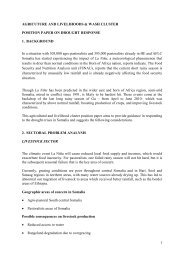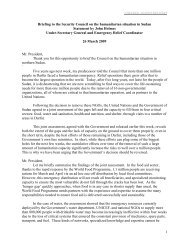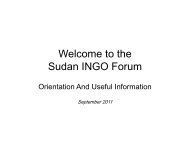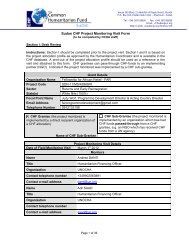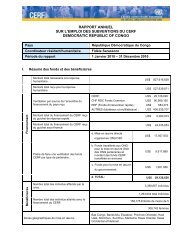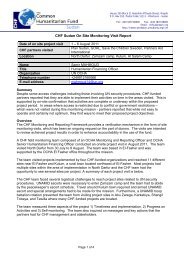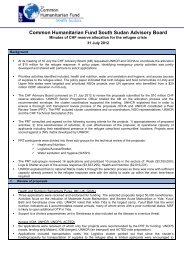Shelter - NFI SPHERE - OCHANet
Shelter - NFI SPHERE - OCHANet
Shelter - NFI SPHERE - OCHANet
Create successful ePaper yourself
Turn your PDF publications into a flip-book with our unique Google optimized e-Paper software.
Minimum Standards in <strong>Shelter</strong>, Settlement and Non-Food Items<br />
7. Design and space provision: the flexible use of the covered space<br />
provided could potentially accommodate different activities at different<br />
times during the day or night. The design of the structure, the location of<br />
openings and the opportunities for alternative internal subdivisions should<br />
enable the internal and immediately adjacent external space to<br />
accommodate livelihood support activities where required.<br />
8. Other functions of shelter: it should be acknowledged that shelter, in<br />
addition to providing protection from the climate, security and privacy for<br />
individual households, etc., also serves other purposes. These include the<br />
establishing of territorial claims or rights, serving as a location at which to<br />
receive relief assistance, and the provision of post-disaster psychosocial<br />
support through the reconstruction process. It can also represent a major<br />
household financial asset.<br />
<strong>Shelter</strong> and settlement standard 4: design<br />
The design of the shelter is acceptable to the affected population and<br />
provides sufficient thermal comfort, fresh air and protection from the<br />
climate to ensure their dignity, health, safety and well-being.<br />
Key indicators (to be read in conjunction with the guidance notes)<br />
● The design of the shelter and the materials used are familiar where<br />
possible and culturally and socially acceptable (see guidance note 1).<br />
● The repair of existing damaged shelters or the upgrading of initial<br />
shelter solutions constructed by the disaster-affected population is<br />
prioritised (see guidance note 2).<br />
● Alternative materials required to provide temporary shelter are<br />
durable, practical and acceptable to the affected population (see<br />
guidance note 3).<br />
● The type of construction, materials used and the sizing and<br />
positioning of openings provides optimal thermal comfort and<br />
ventilation (see guidance notes 4-7).<br />
<strong>Shelter</strong><br />
221




